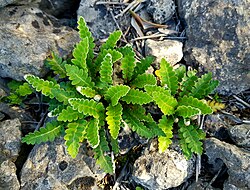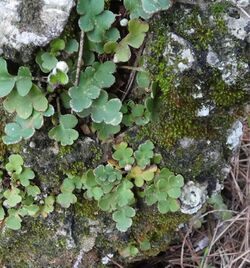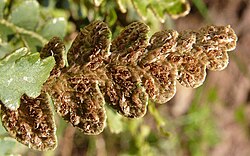Biology:Asplenium ceterach
| Rustyback Fern | |
|---|---|

| |
| Scientific classification | |
| Kingdom: | Plantae |
| Clade: | Tracheophytes |
| Division: | Polypodiophyta |
| Class: | Polypodiopsida |
| Order: | Polypodiales |
| Suborder: | Aspleniineae |
| Family: | Aspleniaceae |
| Genus: | Asplenium |
| Species: | A. ceterach
|
| Binomial name | |
| Asplenium ceterach | |
| Synonyms | |
| |





Asplenium ceterach, also known as the rustyback fern, is a fern species in the spleenwort family Aspleniaceae.[3]
Description
Asplenium ceterach is a perennial and evergreen fern species characterized by its compact size and robust, intricately divided fronds, measuring up to 20 cm in length.[4] The undersides of these fronds are covered in a dense layer of pale reddish-brown scales, of which the rustyback ferns common name originates.[4]
Distribution
Asplenium ceterach has a large Western and Central European distribution, where it is located in the countries of: Albania, Austria, Belgium, Bulgaria, Crimea, Croatia, Cyprus, France, Germany, Great Britain, Greece, Hungary, Ireland, Italy, Kazakhstan, Netherlands, Portugal, Romania, Spain, Sweden, Switzerland. The species is also native to the European island territories of: Baleares, Corsica, Crete, Sardinia and Scilly. It can also be found within the North Caucasus region and European Turkey. A. ceterach is believed to be locally extinct in Poland.[5]
Within Asia Asplenium ceterach can be found within the countries of: Afghanistan, China, Iran, Iraq, Lebanon, Syria, Pakistan, Israel, Tadzhikistan, Turkey, Uzbekistan. The species has a range extending throughout the Transcaucasus region which extends along the West Himalayas where the species can also be found in Tibet.[5]
The African range of Asplenium ceterach includes several countries within North Africa. These countries include Algeria, Djibouti, Libya, Morocco and Tunisia.[5] Just off the coast of Africa the species can also be found living on the Canary Islands.[6]
Habitat
Asplenium ceterach is associated with fissure habitat in carbonate rocks and also grows on the mortar of stone and brick walls. The species can be found growing up to 2700 metres above the sea level, although it prefers mountainous locations, where it is usually found growing on rocky walls and slopes in full sun.
Unlike many others, this fern likes growing in full sun, and requires little, if any, humidity.[7]
Subspecies
Asplenium ceterach exhibits polyploidy within the species with populations in different regions possessing various levels of diploid, tetraploid and hexapoloid forms.[4] Many of these forms are treated as respective subspecies.[4] The following subspecies are recognised:[5]
| Subspecies | Polyploidy | Range |
|---|---|---|
| A. ceterach ssp. ceterach | tetraploid | Occurring throughout the species range from Europe to Tibet. Also present in North Africa. |
| A. ceterach ssp. bivalens | diploid | Central and Eastern Europe: Croatia, Bulgaria, Hungary, Romania, Italy, Greece, Turkey. |
| A. ceterach ssp. cyprium | Native to Mediterranean Europe and North Africa: Cyprus, Greece, Italy, Sardinia, Sicilia, Spain, Tunisia. | |
| A. ceterach subsp. mediterraneum | Native to Greece. |
Hybrid nothospecies
The species also possesses naturally occurring hybrid nothospecies:[5]
| Nothospecies | Polyploidy | Range | Hybrid Formula |
|---|---|---|---|
| A. ceterach nothosubsp. mantoniae | Eastern Central and Southern Europe to South Turkey. | A. ceterach subsp. bivalens × A. ceterach subsp. ceterach | |
| A. ceterach nothosubsp. troodeum | Native to Mediterranean Europe: Cyprus, Italy, Scilly. | A. ceterach subsp. ceterach × A. ceterach subsp. cyprium |
Taxonomy
Linnaeus was the first to describe rustyback with the binomial Asplenium ceterach in his Species Plantarum of 1753.[8]
A global phylogeny of Asplenium published in 2020 divided the genus into eleven clades,[9] which were given informal names pending further taxonomic study. A. scolopendrium belongs to the "Ceterach subclade" of the "Phyllitis clade".[10] Members of the Phyllitis clade have undivided or pinnatifid leaf blades with a thick, leathery texture, persistent scales on their stalk, and often possess anastomosing veins. Members of the Ceterach subclade have pinnatifid leaves, usually with a thick covering of hairs and/or scales and irregularly anastomosing veins.[11]
Traditional uses
Asplenium ceterach has been traditionally used as a medicinal herb. The plant has been historically utilized to treat a large variety of health problems in humans. A. ceterach extract has been used as a mucoactive agent, diuretic and laxative.[12] A. ceterach was also used to treat kidney stones, spleen issues, haemorrhoids and intestinal disorders.[13] The plant has even been used to treat respiratory disorders and hypertension.[13]
Extracts created from A. ceterach display anticancer properties.[13] Extracts possess a selective inhibitory effect against cervical cancer cells and a low cytotoxicity towards healthy non-cancerous cells in humans.[13]
Desiccation tolerance
This fern is well known as a resurrection plant due to its ability to withstand desiccation and subsequently recover on rewetting. It has been shown that this is in part due to its high concentrations of phenolic compounds such as chlorogenic acid and caffeic acid which allow it to negate the destructive capacity of the reactive oxygen species generated by the drying process; the concentrations of these phenols decrease during the dehydration process. Enzymes such as peroxidase and polyphenol oxidase have also been shown to be important in allowing this fern to cope with desiccation; the concentrations of these enzymes increase when the fern is subjected to water shortages.[14]
References
- ↑ Christenhusz, M., Bento Elias, R., Dyer, R., Ivanenko, Y., Rouhan, G., Rumsey, F. & Väre, H. (2016). "Asplenium ceterach". IUCN Red List of Threatened Species 2016: e.T83470465A83470575. https://www.iucnredlist.org/species/83470465/83470575. Retrieved 31 May 2021.
- ↑ {{citation | mode = cs1 | title = Asplenium ceterach | work = Germplasm Resources Information Network (GRIN) | url = | publisher = [[Organization:Agricultural Research ServAgricultural Research Service (ARS), United States Department of Agriculture (USDA) | access-date = 2010-12-14 }}
- ↑ (xls) BSBI List 2007, Botanical Society of Britain and Ireland, https://bsbi.org/download/3542/, retrieved 2014-10-17
- ↑ 4.0 4.1 4.2 4.3 Pinter, Istvan & Bakker, Freek & Barrett, John & Cox, Cymon & Gibby, Mary & Henderson, Sally & Morgan-Richards, Mary & Rumsey, Fred & Russell, Stephen & Trewick, Steven & Schneider, Harald & Vogel, Johannes. (2002). Phylogenetic and biosystematic relationships in four highly disjunct polyploid complexes in the subgenera Ceterach and Phyllitis in Asplenium (Aspleniaceae). Organisms Diversity & Evolution. 2. 299–311. 10.1078/1439-6092-00050.
- ↑ 5.0 5.1 5.2 5.3 5.4 "Asplenium ceterach L.". Plants of the World Online. Royal Botanic Gardens, Kew. https://powo.science.kew.org/taxon/urn:lsid:ipni.org:names:17040860-1.
- ↑ heede, Caroline & Pajarón, Santiago & Pangua, Emilia & Viane, Ronald. (2009). Asplenium ceterach and A. octoploideum on the Canary Islands (Aspleniaceae, Pteridophyta). American Fern Journal. 94. 81-111. 10.1640/0002-8444(2004)094[0081:ACAAOO]2.0.CO;2.
- ↑ "Ceterach Officinarum, Doradilla; Flora and Fauna of Cantabria (Spanish)". http://www.asturnatura.com/especie/ceterach-officinarum.html.
- ↑ Linnaeus, C. (1753). Species Plantarum. II (1st ed.). Stockholm: Laurentii Salvii. p. 1080. https://www.biodiversitylibrary.org/page/359101.
- ↑ Xu et al. 2020, p. 27.
- ↑ Xu et al. 2020, p. 30.
- ↑ Xu et al. 2020, p. 41.
- ↑ Živković, Suzana & Skorić, Marijana & Šiler, Branislav & Dmitrović, Slavica & Filipović, Biljana & Nikolić, Tijana & Mišić, Danijela. (2017). Phytochemical characterization and antioxidant potential of rustyback fern (Asplenium ceterach L.). Lekovite sirovine. 37. 15-20. 10.5937/leksir1737015Z.
- ↑ 13.0 13.1 13.2 13.3 Petkov V, Batsalova T, Stoyanov P, Mladenova T, Kolchakova D, Argirova M, Raycheva T, Dzhambazov B. Selective Anticancer Properties, Proapoptotic and Antibacterial Potential of Three Asplenium Species. Plants (Basel). 2021 May 25;10(6):1053. doi: 10.3390/plants10061053. PMID: 34070269; PMCID: PMC8225096.
- ↑ Suzana Živković (2010). "Dehydration-related changes of peroxidase and polyphenol oxidase activity in fronds of the resurrection fern Asplenium Ceterach l.". Arch. Biol. Sci. 62 (4): 1071–1081. doi:10.2298/ABS1004071Z.
- Xu, Ke-Wang; Zhang, Liang; Rothfels, Carl J.; Smith, Alan R.; Viane, Ronald; Lorence, David; Wood, Kenneth R.; Cheng, Cheng-Wei et al. (2020). "A global plastid phylogeny of the fern genus Asplenium (Aspleniaceae)". Cladistics 36 (1): 22–71. doi:10.1111/cla.12384. PMID 34618950.
- Carrión Vilches, Miguel Ángel (2000). Helechos de la Región de Murcia. Universidad de Murcia, Departamento de Biología Vegetal ; Caja de Ahorros del Mediterráneo. ISBN 84-699-3093-1.
Wikidata ☰ Q1754958 entry
 |


